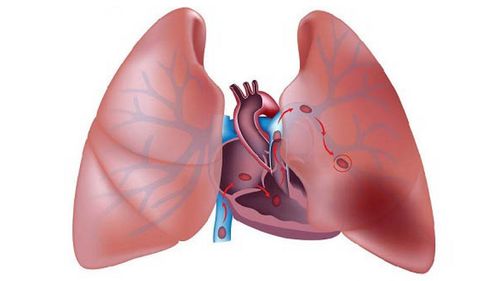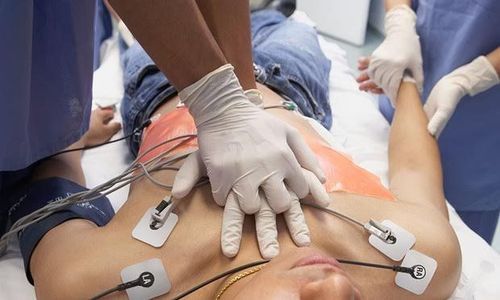This is an automatically translated article.
Pulmonary embolism is one of the quite common complications for patients after undergoing surgery. Pulmonary embolism after surgery often seriously affects the patient's health, can even lead to heart failure and sudden death. Therefore, when there are any signs of pulmonary embolism after surgery, it is necessary to immediately bring the patient to a reputable medical facility for timely treatment.
1. Pulmonary embolism after surgery
Pulmonary embolism is a medical condition caused by blood clots in the body breaking off and moving freely in the blood vessel. These hematomas can travel to certain parts of the body and block blood vessels there. Some blood clots do not move from one location to another in the body, but only concentrate in the veins, also known as deep vein thrombosis, which is also the cause of pulmonary embolism.
In most cases of pulmonary embolism, the cause is from blood clots in the veins of the legs or arms. The mechanism of venous thrombosis causing pulmonary embolism is explained by the fact that the vein receives the task of leading blood into the large vein, then to the heart and pulmonary artery, when blood clots appear in the vein, it will follow. the venous route to the heart, then into the pulmonary artery and finally into the lungs. At this time, the blood clots appearing in the lungs will block blood to the lungs to receive oxygen to supply the body's organs, as a result, the body will experience a lack of oxygen in the blood that affects all the organs. organs in the body including the brain, heart, kidneys... Moreover, when the blood flow is blocked in the lungs, it will put a great pressure on the right heart, causing the right heart to swell and contract more than usual. Thus, the left heart will not be able to pump enough blood for the body, leading to a drop in the patient's blood pressure.

Thiếu oxy trong máu khiến bệnh nhân bị tụt huyết áp
Some of the risk factors that can lead to pulmonary embolism are:
Blood clotting problems can run in families. The body has a problem with varicose veins. The patient has a history of cancer and cardiovascular disease. The patient is pregnant and during the first 6 weeks postpartum. Patients who smoke Patients who are obese Patients who use long-distance vehicles without a reasonable rest After surgery the patient lies for too long or suffers a severe injury Patient uses oral contraceptives and hormone-regulating drugs. Patients over 70 years old. Patient has a history of thromboembolic disease. The patient is not taking blood thinners. Pulmonary embolism can occur after a patient has surgery to treat some diseases related to the body's pelvis such as hernia surgery, gynecological surgery and urinary tract surgery.
In addition, postoperative pulmonary embolism can also occur when the patient performs a gastrectomy, colectomy or miscarriage ... Postoperative pulmonary embolism can be misdiagnosed with other diseases. such as acute pneumonia, atelectasis or pleural effusion.

Sảy thai cũng có thể là nguyên nhân gây tắc mạch phổi
2. Management of pulmonary embolism after surgery
The effects of pulmonary embolism on other organs are the cause of death if the patient is not detected and treated promptly and properly. A postoperative pulmonary embolism patient will be monitored and treated in the ICU intensive care unit. The principle of treatment of pulmonary embolism after surgery is to use drugs that destroy blood clots, and at the same time combine with drugs capable of preventing the formation and growth of new hematomas. Currently the anticoagulants Warfarin and Heparin.

Điều trị tắc mạch phổi sau mổ bằng thuốc trị đông máu
In cases where the patient is contraindicated to thrombolytic drugs, thrombi can be removed from the blood vessels by Catheter or treated with surgical methods of thoracoscopic surgery to remove the clot. It should be noted that severe and dangerous pulmonary embolism in surgery or in obstetrics has a very high risk of leading to acute pulmonary edema, cardiovascular collapse and death, so emergency surgery is required to remove the blood mass. as soon as possible.
Pulmonary embolism after surgery is a fairly dangerous and common complication in most surgeries, causing bad effects on important organs in the body such as the heart, lungs, brain... and can lead to sudden death if not treated early. Therefore, it is necessary to detect early signs of pulmonary embolism so that the patient can be treated or surgically intervened in time.
Vinmec International General Hospital with a system of modern facilities, medical equipment and a team of experts and doctors with many years of experience in neurological examination and treatment, patients can completely peace of mind for examination and treatment at the Hospital.
To register for examination and treatment at Vinmec International General Hospital, you can contact Vinmec Health System nationwide, or register online HERE.
SEE MORE
Symptoms and treatment of chronic obstructive pulmonary disease Tests to help detect chronic obstructive pulmonary disease Treatment of cerebral infarction with thrombolytic drugs













